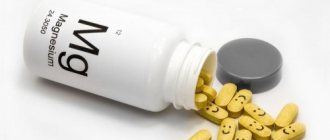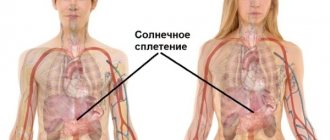What is magnesium needed for?
Scientists have calculated that magnesium is involved in 300 biochemical processes that occur in the body. Deficiency and excess of this element lead to deterioration of health and well-being.
This element affects the normal functioning of the heart and blood vessels. It normalizes blood pressure. Magnesium is required to maintain muscle function.
The effect of magnesium on the functioning of the body:
- removes waste and toxins;
- required for regeneration;
- necessary for cell renewal;
- calms the nervous system;
- improves intestinal motility;
- reduces neuromuscular tension;
- necessary for protein synthesis;
- removes cholesterol;
- promotes the separation of bile.
Thanks to magnesium, vitamins and minerals are better absorbed by the body. For example, if there is a deficiency of magnesium, calcium is less absorbed.
Magnesium for children
A child's growing body needs magnesium.
Often parents do not suspect that inattention and problems with memorizing material at school are associated with a lack of magnesium in the body. Bad behavior, tantrums, conflicts, and depression may be indicators of magnesium deficiency. In adolescence, many tend to associate mood swings with the transition period. But these may also be symptoms of an insufficient amount of a useful element in the body.
The use of magnesium preparations for cardiovascular diseases in children
Magnesium, which is involved in ensuring the most important biochemical and physiological processes in the body, as well as influencing energy, plastic, and electrolyte metabolism, is currently considered one of the most important intracellular microelements. Being a universal regulatory factor, magnesium has a normalizing effect on the functional state of almost all organs and systems (Table 1).
Under physiological conditions, magnesium enters the body with food and water. Magnesium is absorbed throughout the entire intestine, but the bulk of it is absorbed in the duodenum. It is known that the body absorbs only up to 35% of magnesium from food. Magnesium absorption may be increased in the presence of vitamin B6 and certain organic acids (lactic, orotic and aspartic).
The absorption of magnesium in the gastrointestinal tract decreases when there is a large amount of protein and fat in the diet, since magnesium forms insoluble or sparingly soluble compounds with them. Magnesium absorption decreases with excess calcium and phosphates.
The total magnesium content in the adult human body is about 25 g. The percentage of magnesium in various organs and tissues is shown in the figure. In the blood, 60–75% of magnesium is in ionized form.
Magnesium balance is regulated by the kidneys. They can reabsorb up to 99% of the magnesium filtered through the glomerular membrane. Up to 100 mg of magnesium is excreted in the urine per day. Magnesium losses in urine increase under the influence of catecholamines and corticosteroid hormones, which explains the mechanism of deficiency of this microelement during stress. With a reduced intake of magnesium from food, its excretion by the kidneys decreases, and with excess, it increases.
According to the Institute of Nutrition of the Russian Academy of Medical Sciences, the magnesium requirement of an adult is 300–400 mg per day. At the same time, at a young age, in people engaged in physical labor, athletes, pregnant and lactating women, the need for magnesium may increase by an additional 150 mg per day. The recommended average daily intake of magnesium is as follows [3]:
- children under 12 months - 55–70 mg;
- from 1 to 3 years - 150 mg;
- from 4 to 6 years - 200 mg;
- from 7 to 10 years - 250 mg;
- from 11 to 17 years - 300 mg;
- men - 350 mg;
- women - 300 mg;
- pregnant and lactating women - 450 mg.
The magnesium content in food (mg per 100 g of product) is as follows (4):
- buckwheat groats - 200;
- rolled oatmeal - 129;
- oatmeal - 119;
- wheat cereal - 88;
- rice cereal - 48;
- wheat grain bread - 74;
- rye bread - 47;
- whole milk powder - 119;
- skimmed milk powder - 160;
- condensed milk - 34;
- buckwheat groats - 200;
- cheese - 50;
- fish products - 116;
- watermelon - 224;
- peas - 90;
- spinach - 83;
- Brussels sprouts - 42;
- salad - 40;
- carrots - 38;
- raisins - 42;
- hazelnuts - 191.
The prevalence of magnesium deficiency in the population ranges from 16 to 42% [5].
The main causes of magnesium deficiency in the body:
- reduction in consumption (dietary restrictions, heat treatment of foods, excess carbohydrates and fats in the diet);
- increased need (stress, physical overexertion, physical inactivity, periods of growth, pregnancy and lactation, condition after viral and bacterial diseases);
- impaired absorption of magnesium in the intestine associated with diseases of the gastrointestinal tract;
- increased excretion by the kidneys in diseases of the urinary system;
- endocrine pathology (hyperthyroidism, hyperparathyroidism, hyperaldosteronism, diabetes);
- drug therapy (glucocorticosteroids, cytostatics, aminoglycosides).
Magnesium deficiency has no pathognomonic clinical signs. However, the polysymptom nature of this condition makes it possible, based on the clinical picture, to suspect magnesium deficiency in the patient with a high degree of probability.
Clinical manifestations of magnesium deficiency in the body
Cardiovascular: vasospasm, arterial hypertension, myocardial dystrophy, tachycardia, arrhythmias, increased QT interval, tendency to thrombosis, development of atherosclerosis, pathological course of pregnancy (toxicosis and gestosis).
| Drawing. Distribution of magnesium in the body |
Neurological: chronic fatigue syndrome, autonomic dysfunction, decreased attention, depression, fear, anxiety, dizziness, migraine, sleep disorders, paresthesia, tetany.
Visceral (except cardiovascular): bronchospasm, laryngospasm, hyperkinetic diarrhea, spastic constipation, pylorospasm, nausea, vomiting, biliary dyskinesia and cholelithiasis, diffuse abdominal pain, formation of kidney stones.
Muscular: skeletal muscle cramps, increased uterine contractility (miscarriages, premature birth).
To assess magnesium content in the body, various methods are used:
- determination of intracellular magnesium content in erythrocytes and mononuclear cells;
- study of magnesium levels in hair;
- determination of magnesium excretion in urine (stress test);
- assessment of magnesium concentration in blood plasma (norm - 0.8–1.1 mmol/l).
The most common method is to measure plasma magnesium concentrations, but its clinical value is limited. Since Mg++ is an intracellular ion, its concentration in serum is not very informative for assessing its total amount in the body and diagnosing deficiency. Only the presence of hypomagnesemia indicates Mg++ deficiency. In case of hidden (intracellular) deficiency, this indicator remains within the normal range [5].
Having many clinical effects, magnesium is widely used as a medicine for various diseases, and especially for pathologies of the cardiovascular system.
In pediatric practice, for diseases of the cardiovascular system, it is considered advisable to prescribe drugs such as Magnerot, Magne B6, asparkam (Panangin), magnesium citrate (Natural Kalm), as well as medicinal mineral water enriched with magnesium (Donat Magnesium). The latter contains magnesium in an active ionized form (more than 1000 mg/l).
We studied the effectiveness of therapy with magnesium preparations in 35 children and adolescents with cardiorheumatic diseases.
As a source of magnesium, medicinal mineral water Donat Magnesium was prescribed at the rate of 3 ml/kg body weight (single dose) 15–20 minutes before meals, 3 times a day. Course duration: 3 weeks.
After a course of treatment with mineral water, there was a significant (p < 0.05) decrease in the frequency of clinical manifestations of neurovegetative disorders in the majority of the examined patients. At the same time, the most significant dynamics were such clinical manifestations as cardialgia, tachycardia, increased blood pressure (BP), headaches, dizziness, weakness, fatigue, anxiety and irritability, and impaired sleep quality.
The use of magnesium therapy was accompanied by a hypotensive effect in almost all patients. However, complete normalization of blood pressure occurred in 62.5% of cases. In 33.3% of patients (7 people), only a tendency to a decrease in blood pressure was observed. These were children with arterial hypertension during adolescence.
The results of the study showed that magnesium has a clear hypotensive effect with an increase in blood pressure caused by the prevailing sympathicotonic influences in children with autonomic dysfunction. The data obtained are consistent with the authors' opinion about the depressant effect of magnesium on the activity and release of catecholamines, and the partial blockade of adrenaline-sensitive receptors. The influence of magnesium on the central mechanisms of blood pressure regulation cannot be ruled out [9].
The emerging positive dynamics of blood pressure in arterial hypertension indicated the advisability of increasing the duration of the course of magnesium therapy to 4–5 weeks. If it is necessary to prescribe antihypertensive drugs, magnesium preparations should be recommended as a component of combination therapy for arterial hypertension in adolescents.
The positive dynamics of the ECG serves as convincing evidence of the presence of cardiotrophic, antiarrhythmic, vegetotropic effects of magnesium therapy.
A number of medications containing magnesium have been used and continue to be introduced in pediatric cardiology practice. The latter differ in magnesium content, its combinations with various biologically active substances and the mechanisms of their complex effects. Such medicines include the following.
Magnerot is a magnesium salt of orotic acid. One tablet contains 500 mg magnesium orotate (32.8 mg magnesium). Orotic acid stimulates the synthesis of adenosine triphosphate (ATP). Since 90% of intracellular magnesium is bound to ATP, a relative increase in the intracellular ATP store through orotic acid improves the fixation of magnesium in cells. The treatment regimen in different age groups is presented in Table 2.
| Table 2 Recommended doses of the drug Magnerot depending on age [6] |
Magne B6 . Available in tablets or oral solution. One tablet contains 48 mg of magnesium and 5 mg of pyridoxine. One ampoule of solution (10 ml) contains a total of 100 mg of magnesium and 10 mg of pyridoxine. For children weighing more than 10 kg (after one year), it is recommended 5–10 mg per kg of body weight (for magnesium) per day, in two or three doses; children over 12 years old - 3 tablets per day, in three doses.
Asparkam (panangin). One tablet contains 36.2 mg of potassium ion and 11.8 mg of magnesium ion.
Magnesium citrate (natural calm) is an aqueous solution of magnesium carbonate and citric acid. In the body, magnesium citrate normalizes the acid-base balance in conditions of acidosis in various pathological conditions, and especially hypoxia. The above makes its use justified for cardiovascular pathology in children. In addition, citrates are ideal conductors of various biologically active substances into cells; they help neutralize toxins. Due to the interaction of magnesium and citrate, their clinical effects in the body are enhanced.
One teaspoon of the drug solution contains 205 mg of elemental magnesium. For children under 10 years old, it is recommended to take 1/4 teaspoon 1–2 times a day; for children over 10 years old, up to 1/2–1 teaspoon (in the absence of diarrhea).
cardiomagnyl as an antiplatelet agent - a compound of acetylsalicylic acid and magnesium hydroxide (in a tablet - 75 and 15.2 mg, respectively), where the latter plays a protective role, as a non-absorbable fast-acting antacid, has a cytoprotective effect and prevents possible damage to the mucous membrane stomach with acetylsalicylic acid [10, 11].
Cardiomagnyl can be used:
- in adolescents with arterial hypertension who have excess body weight, hyperlipidemia, a tendency to hypercoagulation with a family history of cardiovascular diseases [12];
- in children with subacute and chronic coronaritis, the causes of which were Kawasaki disease, infective endocarditis; as well as for systemic vasculitis, when long-term maintenance antiplatelet therapy is required (at a rate of 1–2 mg/kg).
Thus, a generalization of literature data and analysis of the results of our studies allows us to recommend therapy with magnesium preparations in children and adolescents with diseases of the cardiovascular system in the following conditions:
- vegetative dystonia in sympathicotonic and mixed variants;
- arterial hypertension of adolescence;
- myocardial dystrophy (infectious-toxic cardiopathy);
- heart rhythm disturbances (extrasystole, sinus tachycardia, acquired secondary QT interval prolongation syndrome);
- prevention of arrhythmias in patients undergoing heart surgery [6];
- latent magnesium deficiency;
- taking medications that promote accelerated excretion of magnesium.
Literature
- The use of medicinal mineral water “Donat Mg” for somatic pathology in children: A guide for pediatricians / ed. prof. N.A.Korovina. M., 2004.
- Tereshenko N.P. The role of magnesium in maintaining acid-base balance // Abstracts of the report of the IV Russian Congress of Pediatricians, October 2005.
- Tutelyan V. A., Spirichev V. B., Sukhanov B. P., Kudasheva V. A. Micronutrients in the diet of a healthy and sick person: A reference guide to vitamins and minerals. M., 2002. pp. 174–175.
- Skalny A.V. Microelements for your health. M., 2003. pp. 81–85.
- Gorodetsky V.V., Talibov O.B. Magnesium preparations in medical practice. Small encyclopedia of magnesium. M., 2004.
- Altura BM Basic biochemistry and physiology of magnesium. A brief review. Magnesium and Frace Elements 1991; 10: 167–171.
- Kroll MN Elin RJ Relationships between magnesium and protein concentrations in serum // Clin. Chem. 1995; 31: 244–246.
- Shkolnikova M.A. Metabolism of magnesium and the therapeutic value of its preparations. - M., 2002. 28 p.
- Davies AO, Mares A., Pool JL, Taylor AA Mitral valve prolapse with symptoms of beta-adrenergic hypersensitivity. Beta 2-adrenergic receptor supercoupling with desensitization on isoproterenol exposure // Amer. J. Med. - 1987; 82 (2): 193–201.
- Ostroumova O. D. Acetylsalicylic acid is the number one drug for the treatment of cardiovascular diseases: main indications for use, clinical benefits, effective doses and ways to increase tolerability // Breast Cancer. 2004. T. 11. No. 5. P. 275–281.
- Barkagan Z. S., Kotovshchikova E. F. Comparative analysis of the main and side effects of various forms of acetylsalicylic acid. 2004, 13 (3).
- Leontyeva I.V. Lectures on pediatric cardiology. M., 2005. pp. 17–30.
N. A. Korovina , Doctor of Medical Sciences, Professor T. M. Tvorogova , Candidate of Medical Sciences, Associate Professor L. P. Gavryushova , Candidate of Medical Sciences, Associate Professor RMAPO, Moscow
Daily intake of magnesium
How much magnesium does a person need to maintain normal health? It all depends on age and the functioning of internal organs. In stressful situations and depression, more magnesium is required.
With any physical or emotional overload, the need for the element increases.
Scientists give average figures that give an idea of how much of this element a person needs.
Requirement for the element magnesium, per 24 hours:
| category, age | quantity, mg |
| men under 35 years old | 390 |
| men over 35 years old | 240 |
| teenagers 14-18 years old | 400 |
| women during lactation | 360 |
| pregnant women | 320-450 |
| women under 35 years old | 310 |
| women over 35 years old | 320 |
| children 10-14 years old | 270 |
| children 6-10 years old | 170 |
| children 3-6 years old | 120 |
| children 1-3 years old | 80 |
| newborns | 40-60 |
Athletes require the greatest amount of magnesium during active sports. In these cases, magnesium will require about 600 mg. If the element is missing in old age, Alzheimer's disease may develop.
Magnesium deficiency occurs in 10-15% of the entire world population.
What prevents it from being absorbed?
Magnesium deficiency occurs in areas where people drink water that is too soft and lacks minerals. Magnesium is very well excreted from the body through fluids, and its deficiency easily occurs when using diuretics or laxatives
, including those included in weight loss products.
Magnesium is lost in large quantities when drinking alcohol
. Moreover, its loss does not depend on the strength of alcohol - any alcohol-containing drink is a strong diuretic. By the way, excessive coffee consumption also leads to magnesium deficiency. This drink also promotes the active removal of fluid from the body. A lack of magnesium is observed both in people who eat mainly refined foods and in those whose diet consists mainly of meat products.
Products containing magnesium
The natural question is, what foods contain magnesium? Most of the food we eat daily contains this element.
Table of magnesium content in products, per 100 g:
| the product's name | amount, in mg |
| wheat bran | 590 |
| pumpkin seeds | 520 |
| cocoa powder | 480 |
| sunflower seeds | 370 |
| coffee | 320 |
| chocolate | 300 |
| black caviar | 300 |
| cashew nuts | 270 |
| pine nuts | 270 |
| watermelon | 230 |
| peanut | 210 |
| seaweed | 170 |
| oat flakes | 160 |
| walnuts | 160 |
| rice | 140 |
| pearl barley | 130 |
| dried apricots | 110 |
| buckwheat | 100 |
In addition, less than 100 mg is found in spinach, raisins, dates, corn, bananas, beets, cottage cheese, potatoes and other products.
The most important
Magnesium is necessary for the functioning of all body systems: it helps cells receive energy, regulates the functioning of the heart and nervous system, and participates in the formation of bone tissue.
A lack of magnesium is caused by an unbalanced diet, addiction to diuretics and laxatives, as well as an addiction to alcohol and coffee. Tags:
- Alcohol
- Metabolism
- Avitaminosis
- Caffeine
- Calcium
- Dictionary
To leave a comment you must be an authorized user









